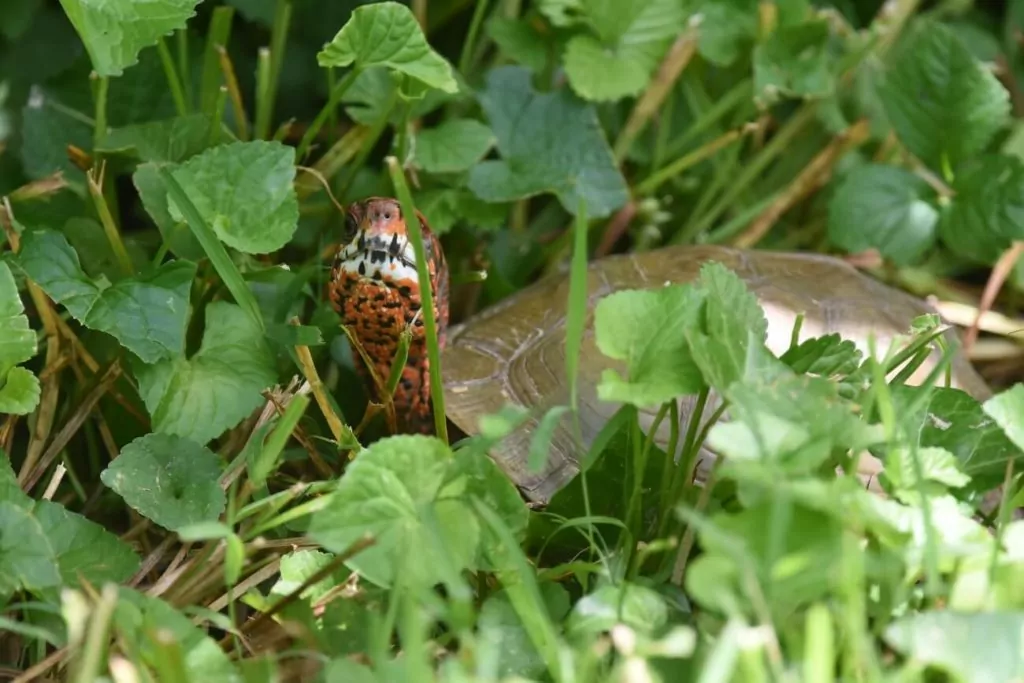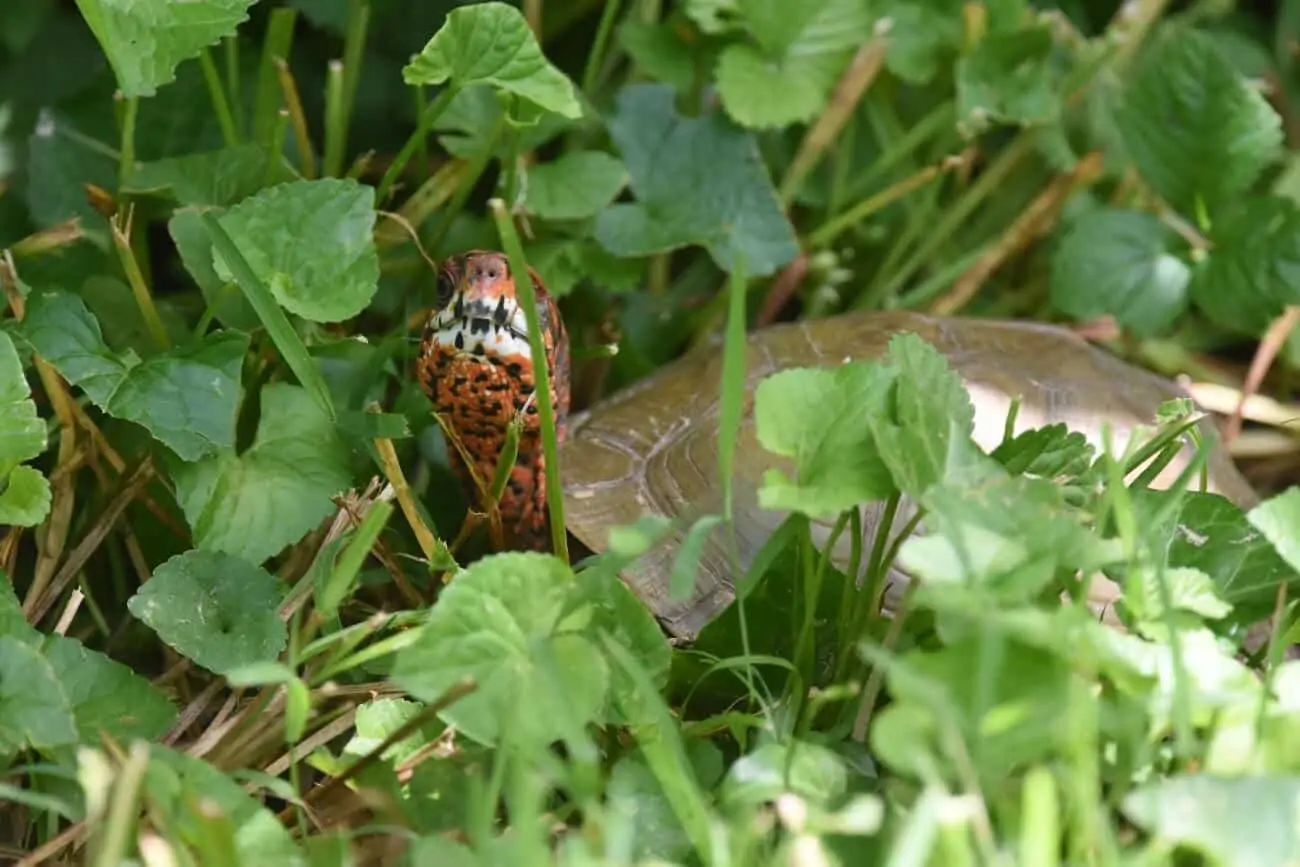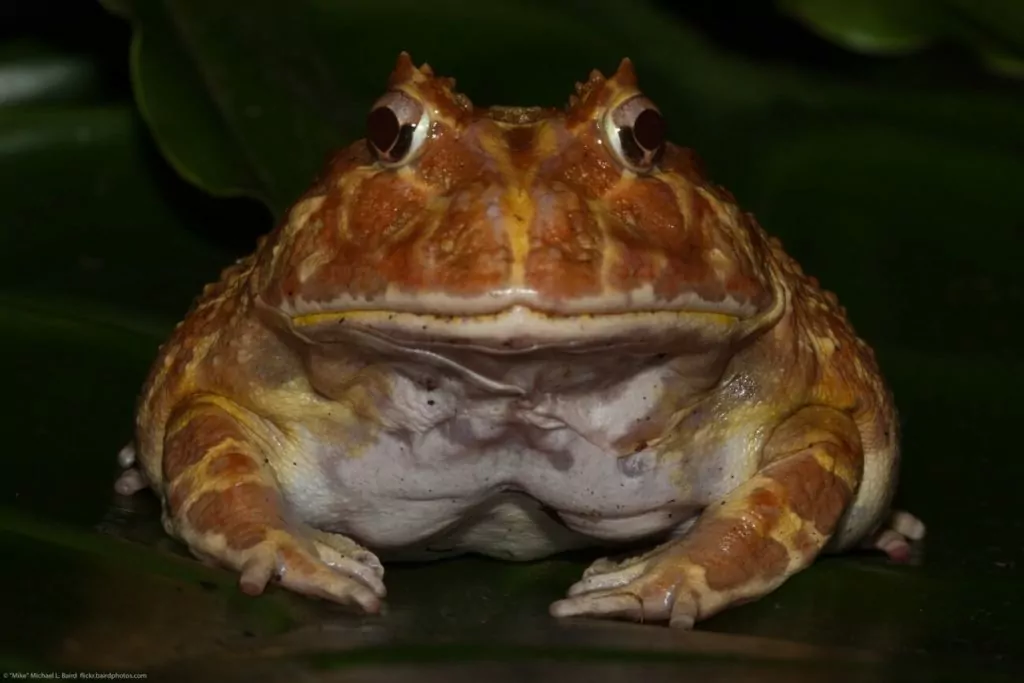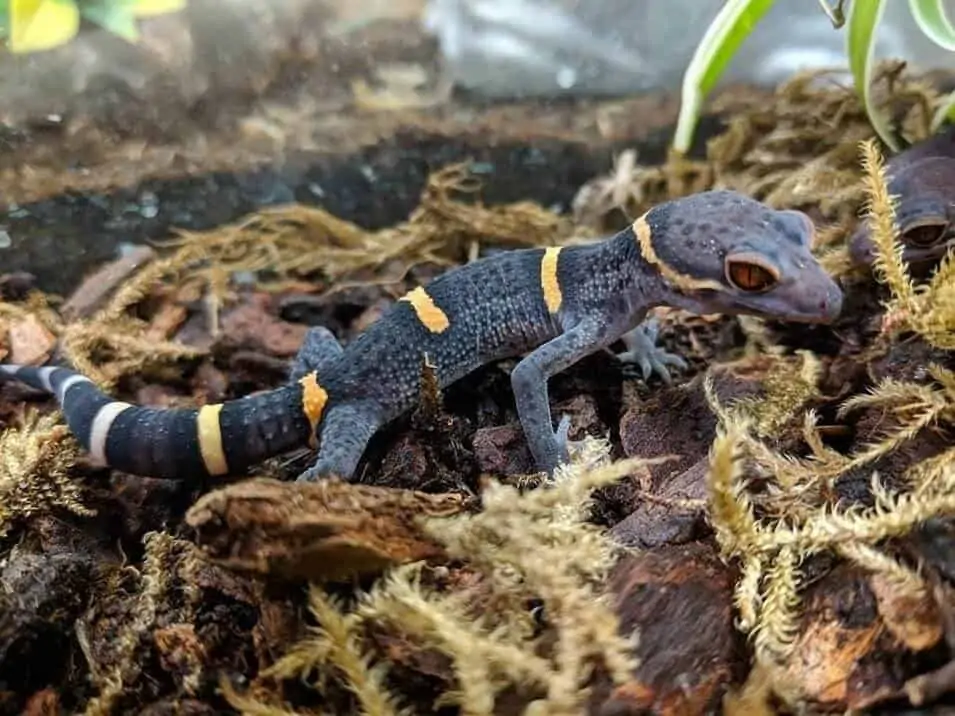Three-toed box turtles are a great pet reptile that we recommend quite often. They’re calm, peaceful, and surprisingly fun to observe!
But you need to have a strong understanding of their care requirements if you expect them to thrive. Caring for them is not as straightforward as you might think.
This guide goes into everything you need to know when it comes to three-toed box turtle care. Diet, habitat setup, lifespan, plus other helpful facts and information are all included!
Table of Contents
Species Summary
The three-toed box turtle (Terrapene carolina triunguis) is a subspecies of box turtles found in marshy areas of states like Missouri, Texas, Alabama and Louisiana. In fact, this pet turtle is Missouri’s state reptile.

As their name indicates, the three-toed box turtle has three toes on each of their hind feet. However, there is some debate among turtle experts as to whether four-toed varieties of this subspecies also exist (something to look into if you’re a turtle nerd).
This popular turtle is actually quite tricky to take care of. It is prone to anxiety, does not like to be handled, and has quite a few finicky habitat requirements.
Expert Tip: If you are a novice turtle owner, we do not recommend the three-toed box turtle as a “starter” species. It’s better suited for owners with a little bit of experience under their belts. We’ll explain why a bit later in the guide.
Appearance & Colors
If you’re looking for a turtle with flashy colors or interesting patterns, the three-toed box turtle might not stand out to you. That being said, this reptile has a subtle beauty that a true turtle enthusiast will appreciate.
The three-toed box turtle has a high-domed carapace that is an earthy shade of rich olive greenish-brown with some yellow markings.

The body of this turtle is where you will often see a bit more color. The skin of the three-toed turtle is a brownish color with yellow spots. Male three-toed box turtles will sometimes have red markings on the head and red, orange and black on the forelegs.
Lifespan
The typical three-toed box turtle lifespan is around 30 to 40 years when bred in captivity. However, the lifespan of this reptile can vary greatly depending on where it comes from (and where it’s kept).
Three-toed box turtles living in the wild can live for up to 100 years! On the other hand, if you get one from the wild and attempt to move it into captivity, it will likely only live for about one year.
Expert Tip: Captive bred is the most common origin for these pets, so the 30 to 40 year mark is what you’ll likely see. Of course, providing good care will certainly help improve the chance of them reaching their maximum life expectancy.
Average Size
The average size of an adult three-toed box turtle is between 3.5 inches and 6 inches long (measured by their carapace). Hatchlings will usually have a carapace size of around 1.5 inches.
Females tend to be slightly larger than males, but their build is very similar.
Three-Toed Box Turtle Care
Three-toed box turtle care requires a certain amount of expertise. We consider this particular turtle to be for intermediate to advanced owners. When properly cared for, these turtles can make excellent pets that you’ll have for a long time.
Your turtle is going to need a large, safe enclosure, a humid environment, plenty of fresh water sources and a balanced diet.
Perhaps the most important aspect of three-toed box turtle care is to have lots of respect for their temperament (more on that later). These turtles are shy, nervous and easily stressed, and they need a peaceful space where they can feel safe.
Enclosure Size
One thing to remember is that three-toed box turtles need lots of living space. This may seem counterintuitive given their size, but three-toed box turtles require lots of room to wander around while looking for food.
If possible, you should keep your three-toed box turtles in an outdoor enclosure. Giving them an enclosure size of 10′ x 12′ will ensure that they have enough space to roam, burrow and relax.
This space can also quite comfortably house several of these reptiles. Because they love to burrow, it’s very important to sink the enclosure barriers at least ten inches into the soil. This will help keep them from escaping accidentally.
Expert Tip: Three-toed box turtles kept in outdoor enclosures can become prey to lots of animals like raccoons, rats and coyotes. Every outdoor living space must have some kind of protective covering that will keep them safe.
If you decide to keep them in an indoor habitat, then they’ll need a living space of around 48″ x 12″. Never use a glass terrarium for indoor housing. Three-toed box turtles are very confused by glass and will obsessively try to climb the glass walls. They are much happier in an enclosure that doesn’t have see-through walls.
Habitat Setup
When you’re planning the interior of your three-toed box turtle habitat, think about what would give your turtle the most happiness and security. This should include plenty of water sources, soft places to burrow and lots of room to wander around.
If you’re creating an outdoor habitat, you’ll want to place the enclosure on top of well-drained soil. Next, you’ll need to choose an appropriate substrate (this aspect applies to both indoor and outdoor enclosures).
Three-toed box turtles need a ground layer that stays moist but does not get too wet. Some recommended substrates include peat moss, cypress mulch, or coconut husk fibers mixed with bark chips and sand.
Expert Tip: It’s very important to make sure that all substrates are toxin-free. Never use cat litter, newspaper, styrofoam or pine bark as a substrate. These substrates can be toxic or can cause choking if ingested.
Temperature & Lighting
Like all reptiles, your three-toed box turtle has no way to internally regulate its body temperature.
Because of this, you will need to provide gradient heating in your enclosure. Gradient heating is when you make one side of your enclosure a warm place for basking and another side for cooling down.

If you have an outdoor set-up, make sure to provide your three-toed box turtle with a variety of sunny and shady areas. This lets your turtle regulate its temperature as it would in the wild. Adding places to hide and cool down will make your turtle very happy (and help them feel safe).
Indoor enclosures will require a different temperature configuration, but the theory remains the same.
The temperature gradient should be between 75 degrees and 88 degrees Fahrenheit (from one side of the habitat to the other). The temperature at night should never drop below 70 degrees.
Ceramic heaters are an excellent choice for creating the warmer basking temperatures your three-toed box turtle loves.
Three-toed box turtles that are kept in outdoor enclosures will receive plenty of UVB light, but you are going to have to provide your indoor turtles with artificial UVB lighting.
If your turtle doesn’t receive enough UVB light, it can develop multiple health issues. Using a fluorescent lamp in your enclosure will give your turtle all the UVB light it needs to maintain a healthy shell and strong bones.
Expert Tip: We recommend using a mercury vapor bulb to provide both heat and UVB light. Make sure to use a 12 hour on, 12 hour off schedule for your lighting.
Humidity
Humidity within the enclosure should remain between 70 to 80 percent. Misting the enclosure several times a day will help maintain the humidity levels and prevent them from dropping.
Some pet owners also use a sprinkler to provide enough moisture (if you’re keeping these pets outside). Always use a reliable hygrometer to consistently keep tabs on the humidity in their habitat.
Water
Three-toed box turtles adore water. They love to soak in it, drink it, and have it nearby! With that in mind, you’ll want to provide your turtle with plenty of places in the enclosure where they can enjoy the fresh, clean water they crave.
To prevent injuries, never make the water container too large or too deep. Shallow pans of water are the best. If you are using an outdoor enclosure, you can dig a shallow hole and line it with a rubber garden pond liner. This “natural” touch will help your turtle feel comfortable in its new home.
Three-Toed Box Turtle Diet & Food List
One good thing about three-toed box turtles is that they’re not too picky when it comes to food. Since they are omnivorous, they will enjoy anything from mealworms and pre-killed mice (yes, really) to squash and kale.
To keep your pet happy and healthy, make sure that half of their diet is made up of fruits and vegetables. Bibb lettuce, spinach, sweet potato, and cantaloupe are great choices.
For the meaty portion of their diet, we suggest feeding them an assortment of items that includes earthworms, super worms, crickets or slugs.
Expert Tip: We recommend feeding your adult turtle two or three times a week. Hatchlings can be fed every other day. Sprinkle vitamin and mineral supplements over the food at least twice a week as well.
Potential Health Issues
Three-toed box turtles are prone to a myriad of health issues that you, as their caretaker, should be aware of.
Before we get into the discussion of health issues, we would like to stress that a strong relationship with a local veterinarian is very important. If your turtle seems sick, it’s always smart to take it into the vet as soon as possible if you want to play it safe.

Some of the common health issues you should look out for include:
Respiratory infections: Like many reptiles, three-toed box turtles are susceptible to respiratory infections. These infections are usually caused by a Vitamin A deficiency, malnutrition, incorrect enclosure temperature or humidity or any number of bacteria, viruses or fungi.
Some signs that your turtle has a respiratory infection are drooling, mucus in the nose, open-mouthed breathing or wheezing. Take your turtle to the vet immediately if you suspect a respiratory infection.
Vitamin A deficiency: A lack of correct nutrition can cause a dangerous Vitamin A deficiency. This can cause changes in the mucus membranes and epidermis. Lethargy, a decreased appetite and eye or ear swelling can be signs of a Vitamin A deficiency.
Shell rot: Turtle shell rot is a big problem for these reptiles, and it can quickly become serious. This condition is usually caused by a bacterial or fungal infection and needs intensive treatment from a veterinarian.
Parasites: There are a number of parasites that can really plague your turtle, so it’s important to have them tested by a vet. This step is especially critical if you have a new turtle. Your vet will take a fecal sample and look for other signs of a parasite infestation.
Eye disease: Conjunctivitis and ulcerated corneas are other health problems that can be seen in three-toed box turtles.
MBD: Like most reptiles, these turtles can suffer from metabolic bone disease. This is caused by a lack of UVB light, and it can be easily prevented by the use of UVB lighting in the enclosure.
Behavior & Temperament
Three-toed box turtles have a sweet, shy temperament. However, they are easily stressed and can become very nervous if they are not kept in a quiet and peaceful habitat. That’s why it is so critical to provide plenty of places for them to hide when they feel scared.
These turtles love to burrow, so giving them lots of soft soil, leaves and other substrate materials will make them very happy. It’s actually rather fun to watch them dig around!
Your three-toed box turtle is a diurnal creature that is most active during the cooler morning hours. You’ll see them searching for food before they slow down in the warmer hours.
Handling Advice
One key fact to remember is that three-toed box turtles do not like to be handled. As much as you may be tempted to pick it up and interact with it, your pet will not find this enjoyable.
They are nervous and easily stressed, and they just want to be left alone to do their thing in peace and safety.
If you do need to pick them up or move them, be gentle and minimize the amount of time you’re holding them as much as possible. This is something you’ll get better at over time!
Conclusion
Three-toed box turtle care might seem a little intimidating at first, but it’s quite manageable if you’re a confident and semi-experienced owner.
These pet reptiles are quite underrated and have far more personality than people give them credit for. We’ve loved this species for years, and find ourselves recommending them a bunch!
If there’s anything you think we should add to this care sheet or questions you’d like us to answer, reach out to us directly. We love talking with our readers and giving them a hand whenever possible!



